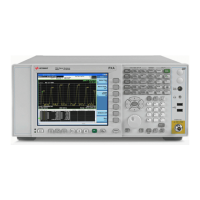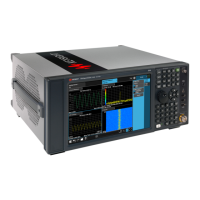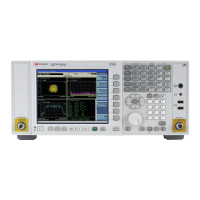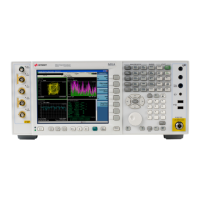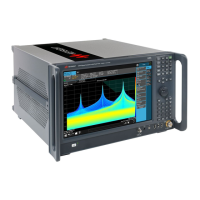10 | Keysight | N9038A MXE EMI Receiver Self-Guided Demonstration - Demo Guide
Demo 4: Multiple trace scan to view max hold and current
signal values
The recommended commercial prescanning methodology requires that suspect
emissions be collected while the device is rotated on a turntable and antenna heights
are scanned. This ensures that identification of all signals that might exceed the limit.
You can use the multi-trace capability of the MXE to simplify this collection and provide
insight into which instrument orientation contribute the highest signal levels.
In this demo, we will use Trace 1 in the max hold trace to capture a summary of the
emissions from the measured turntable azimuths and antenna heights. In addition, we
will use Trace 2 in the clear/write trace to capture the emissions profile of the current
DUT position. The signals in Trace 1 will be tested against Limit Line 1 and written to the
suspect list.
Figure 9. Swept traces in both clear write and max hold trace types; whip antenna
length was changed during the sweep to simulate antenna height scan, resulting in the
difference between the traces
Step 1— Demo 4 Instructions for MXE Keystrokes
Turn on all three meters
It’s not necessary to turn on three detectors for scanning,
searching, and measuring, but it’s helpful to see three meters for
turning signals later in the process
Note: For MIL-STD measurements, do not turn on Meters 2 and 3
[Mode setup], {Meters Control}, {Meters}, {Select Meter}, {Meter 2}, {Meter On},
{Detector (Meters)}, {Quasi Peak}
[Mode Setup], {Meters Control}, {Meters}, {Select Meter}, {Meter 3}, {Meter On},
{Detector (Meters)}, {EMI Average}
Set scan sequence to scan only [Meas Setup], {Scan Sequence}, {Scan Only}. This is the default setting
Set frequency scan in continuous mode
[Sweep/Control], {Frequency Scan Cont}. This is the default setting
Set Trace 1 to max hold trace type and set the detector to peak.
Trace 1 is the yellow trace
[Trace/Detector], {Select Trace}, {Trace 1}, {Max Hold} {More 1 of 2}, {Detector
(Trace)}, {Peak}
Set Trace 2 to clear write trace type and the detector to peak.
Trace 2 is the blue trace
[Trace/Detector], {Select Trace}, {Trace 2}, {Clear Write}, {More 1 of 2}, {Detector
(Trace)}, {Peak}
Set scan type to smooth [Meas Setup], {More 1 of 3}, {Scan Type}, {Smooth}. This is the default setting
Start a scan with smooth scan type [Sweep/Control], {Start} or {Clear List And Start}, or just press [Restart]
The {Clear List And Start} will clear the signal list table before a new scan
Observe the two traces updating, then stop the scan. See Figure 9 [Sweep/Control], {Stop}
Did you know?
The MXE’s digital IF architecture
guards against IF overload, even
if signals are above the reference
level. This architecture allows you to
reduce operator error by eliminating
overload caused by incorrect
reference level settings.

